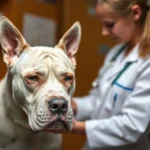
Introduction
Brachycephalic syndrome in dogs refers to a collection of respiratory issues that affect breeds with short muzzles. The term “brachycephalic” originates from the Greek words “brachy,” meaning short, and “cephalic,” meaning head. These dogs, including popular breeds like Bulldogs, Pugs, and Boxers, have distinctive anatomical features such as shortened skulls and flattened faces. Unfortunately, this unique structure can lead to various health complications, especially concerning their respiratory systems.
The prevalence of brachycephalic syndrome is increasingly concerning for dog owners, as these breeds become more popular. As pet enthusiasts seek to adopt these adorable companions, it is crucial to understand the challenges they may face regarding respiratory health. Awareness of this syndrome is vital for ensuring the well-being of our beloved pets.
Understanding Brachycephalic Syndrome
What is Brachycephalic Syndrome?
Brachycephalic syndrome encompasses a range of anatomical abnormalities that can obstruct airflow in affected dogs. Common features include elongated soft palates, narrowed nostrils, and hypoplastic tracheas. These structural issues can lead to chronic breathing difficulties and other related health problems.
Dogs with this syndrome often experience respiratory issues, particularly during physical exertion or in hot weather. The inability to effectively cool themselves through panting can lead to heat stress, making it essential for owners to proactively manage their dog’s environment and activity levels.
Causes and Risk Factors
The primary cause of brachycephalic syndrome is genetic predisposition, rooted in selective breeding practices that emphasize physical traits over health considerations. Over the years, breeders have favored shorter muzzles and larger eyes, inadvertently creating a population of dogs that suffer from compromised respiratory function.
Environmental factors can exacerbate the severity of the syndrome. For instance, exposure to high temperatures, humidity, or high levels of stress can worsen breathing difficulties in brachycephalic dogs. Understanding these risk factors is crucial for managing the health of these breeds effectively.
Symptoms of Brachycephalic Syndrome
Common Signs to Look For
Recognizing the symptoms of brachycephalic syndrome is essential for early intervention. Common signs include:
- Difficulty breathing: Dogs may exhibit increased respiratory effort, with noticeable labored breathing.
- Snoring and snorting sounds: Many brachycephalic breeds are notorious for their loud breathing noises during sleep or rest.
- Exercise intolerance and lethargy: Dogs may tire easily during walks or play, often sitting down or panting excessively.
When to Seek Veterinary Help
It is vital for dog owners to be vigilant about their pets’ health. Signs of distress, such as excessive panting, coughing, or even collapse, require immediate veterinary attention. Early diagnosis and intervention can significantly improve the quality of life for dogs suffering from brachycephalic syndrome.
Diagnosis of Brachycephalic Syndrome
Veterinary Examination Procedures
When you take your dog to the veterinarian for suspected brachycephalic syndrome, a comprehensive examination will typically include:
- Physical examination: The vet will assess respiratory function, listen to your dog’s heart and lungs, and check for any obvious anatomical abnormalities.
- Diagnostic imaging: X-rays or CT scans may be conducted to evaluate the airway structure, helping to determine the severity of the condition.
Differential Diagnoses
It is essential to distinguish brachycephalic syndrome from other respiratory conditions. Other potential diagnoses may include:
- Allergies
- Infectious diseases (such as kennel cough)
- Other forms of respiratory distress
Your veterinarian will consider these factors and run necessary tests to ensure an accurate diagnosis.
Treatment Options
Conservative Management
For many dogs, conservative management is the first line of treatment for brachycephalic syndrome. This may include:
- Lifestyle changes: Weight management is crucial, as excess weight can exacerbate breathing difficulties. Keeping the dog in a cool environment, especially during hot weather, is also essential.
- Medications: Anti-inflammatory medications or bronchodilators may be prescribed to alleviate symptoms and improve respiratory function.
Surgical Interventions
In more severe cases, surgical options may be necessary to improve airflow. Common procedures include:
- Soft palate resection: This surgery shortens the elongated soft palate, which can obstruct the airway.
- Nostril widening: This procedure enhances airflow through the nostrils by widening the openings.
While surgery can significantly improve the quality of life for affected dogs, it is essential to discuss the risks and benefits with your veterinarian. Post-operative care and recovery will also require attention to ensure a successful outcome.
Prevention Strategies
Choosing the Right Breed
When considering bringing a dog into your home, it is crucial to research the breed’s health issues. Potential dog owners should be aware of the risks associated with brachycephalic syndrome and consider adopting breeds with fewer respiratory concerns.
Ethical Breeding Practices
Supporting ethical breeding practices is vital in reducing the prevalence of brachycephalic syndrome. Responsible breeders prioritize the health and welfare of their dogs, aiming to produce offspring that do not suffer from debilitating health conditions.
Lifestyle Adjustments for Brachycephalic Dogs
Owners of brachycephalic dogs should implement lifestyle adjustments to keep their pets healthy:
- Regular vet check-ups: Routine examinations can help catch any developing issues early.
- Monitoring weight and diet: Keeping your dog at a healthy weight will reduce the strain on their respiratory system.
Living with a Brachycephalic Dog
Daily Care Tips
Caring for a brachycephalic dog requires special attention and routine management. Here are some essential daily care tips:
- Managing exercise and playtime: Engage in low-impact activities, especially during warmer months. Shorter, more frequent walks can help maintain your pet’s fitness without overexertion.
- Keeping the dog cool: During hot weather, ensure your dog has access to shade and fresh water. Consider using fans or air conditioning to maintain a comfortable environment.
Monitoring Health
Being proactive about your dog’s health is key. Look for signs of worsening symptoms, such as:
- Increased respiratory effort
- Excessive panting or coughing
- Changes in appetite or behavior
Always consult your veterinarian if you notice any concerning changes in your dog’s health.
Frequently Asked Questions (FAQs)
What breeds are most affected?
Commonly affected breeds include Bulldogs, Pugs, Boxers, Shih Tzus, and Boston Terriers. These breeds are more prone to brachycephalic syndrome due to their anatomical features.
Can brachycephalic dogs live normal lives?
Yes, with proper management and care, many brachycephalic dogs can lead normal, happy lives. Regular veterinary check-ups and responsible ownership can help minimize complications.
How can I help my dog if they are experiencing breathing difficulties?
If your dog shows signs of breathing difficulties, remain calm and avoid panicking. Try to keep your dog cool and comfortable, and contact your veterinarian immediately for advice.
Conclusion
Understanding brachycephalic syndrome is essential for any dog owner considering adopting a brachycephalic breed. Awareness of the symptoms, potential complications, and management options can significantly improve the quality of life for these dogs. If you have concerns about your pet’s health, don’t hesitate to reach out to your veterinarian for guidance and support.









